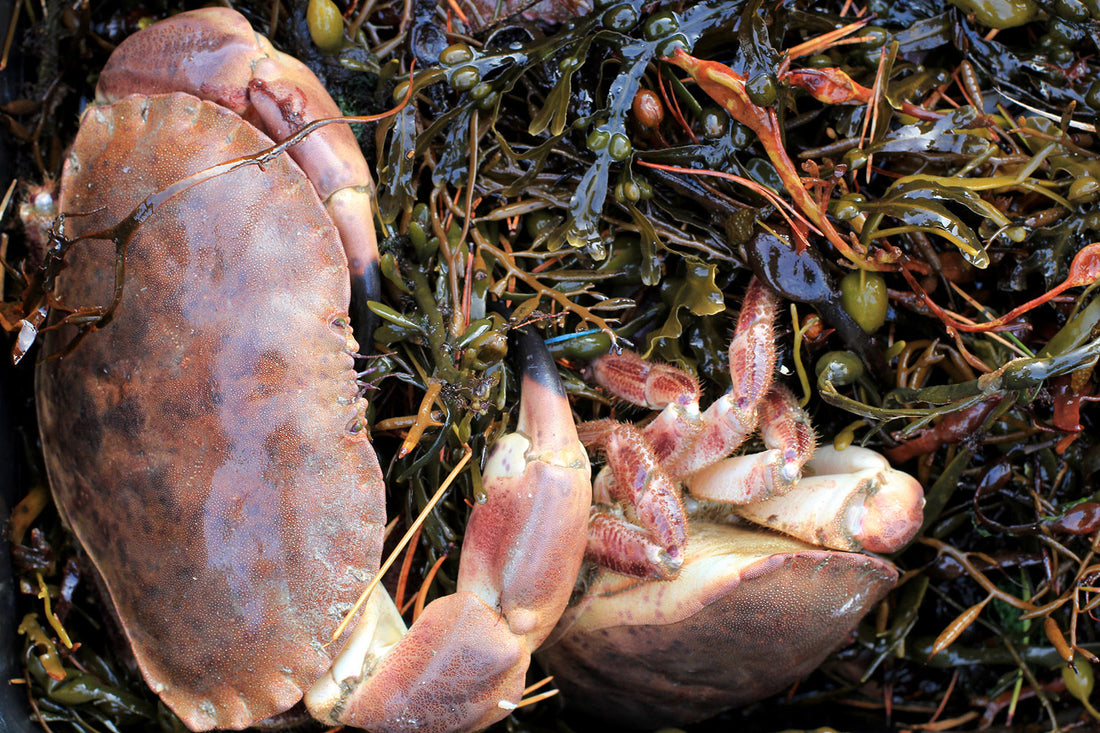Autumn is here and the crabs are filling up with food! Here is a small blog about experiences around snorkelling and freediving for crab after dark.

PLANNING
Check weather forecast and tides. The crabs pull all the way up into the water's crust to feed on the rudder when the tide is high. A perfect timing would be to start about 2 hours before full tide. The net is then well covered by water, and the crabs are clearly visible when they emerge from the kelp. Bring several fishing nets, and mark the buoy with a signal light. A small mask light is excellent when looking for crabs.
Smart products for crab lighting:
Catch net
Bending light that makes you visible on the surface
Small mask lantern
Mask attachment for mask light
PICKING CRABS
The crabs are surprisingly quick when underwater. When you shine the light on the crabs, they quickly move down towards the kelp to hide. One of the lessons we learned was that it was best to use a lantern that is not too powerful. A medium concentrated cone of light is perfect. Then you can illuminate limited areas as you move along the rock wall. With too powerful a light, some crabs will pull away before you see them. The chalky white glass will produce strong light reflections, which is unpleasant as you will be dazzled. If your lantern is a little too powerful at full strength, you can reduce the output a little (many models have several settings).
Among other things, we used the Orcatorch D550 with a wrist mount from OrcaTorch, and it worked great. They were small and handy, while at the same time shining very well for this use.
Another exciting observation we made was how the small crabs came to the surface where there were hilly and gentle slopes down towards the depths. In the steeper walls there were larger crabs. Before the next trip, we will look carefully at sea charts to find steeper walls that hit the sandy bottom at between 10 and 20 meters deep.
In the name of hindsight. We should have brought the small lanterns that you can attach to the mask . When working with your hands, it would have been nice to have a lantern that illuminated the netting and your hands.
Recommended lanterns for crab lighting:
Orcatorch D580 (530 lumens)
Orcatorch D520 (1000 lumens)
Orcatorch D550 (1000 lumens)
Orcatorch wrist mount WS01
FILMING WITH LIGHT
We also had a GoPro camera with us to make a small video of the trip. We therefore took a quick test of the OrcaTorch D500V+ (V for Video). (This model has now been replaced with the Orcatorch D530V ) In the editing work after the trip, it was easy to see that this lantern should have been used more. The video light has a completely flat light (no focal point). Thus, the colors and rendering of the video are MUCH better. In the video at the top of the article, you can easily see the difference between when we film with a normal flashlight or with the video flashlight. See all video lights here .
Want to read more? Here are articles for inspiration and use:
Autumn is here and the crabs are filling up with food! Here you can read about the pocket crab and be inspired by the recipe for a delicious crab salad.
Read article
NIGHT DIVE IN ALVERSTRAUMEN
Finally we had reached the highlight of Christmas, the obligatory night dive! A wonderful break from food, cakes and more food. The plan was ready. The Elverstraumen between Lindås and Radøy was supposed to explore the onset of darkness.
Read article
LIGHTS FOR NIGHT DIVING
With underwater lights you can be in the water all year round. The lanterns are available in many sizes and they can be attached to the harpoon, on the handle joint, in the mask (own type of lantern) and carried in the hand.
Read article
Article on dykking.no:
Here are some tips for crab season
When it gets dark in the evening, it is a sign that the crab season starts. Now the crabs are at their best going forward, and divers can fortunately pick as much as they want.
Read article

